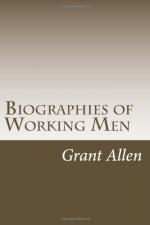For twenty-seven years Gibson remained at Rome, working assiduously at his art, and rising gradually but surely to the very first place among then living sculptors. His studio now became the great centre of all fashionable visitors to Rome. Still, he made no effort to get rich, though he got rich without wishing it; he worked on merely for art’s sake, not for money. He would not do as many sculptors do, keep several copies in marble of his more popular statues for sale; he preferred to devote all his time to new works. “Gibson was always absorbed in one subject,” says Lady Eastlake, “and that was the particular work or part of a work—were it but the turn of a corner of drapery—which was then under his modelling hands. Time was nothing to him; he was long and fastidious.” His favourite pupil, Miss Hosmer, once expressed regret to him that she had been so long about a piece of work on which she was engaged. “Always try to do the best you can,” Gibson answered. “Never mind how long you are upon a work—no. No one will ask how long you have been, except fools. You don’t care what fools think.”
During his long life at Rome, he was much cheered by the presence and assistance of his younger brother, Mr. Ben, as he always called him, who was also a sculptor, though of far less merit than John Gibson himself. Mr. Ben came to Rome younger than John, and he learned to be a great classical scholar, and to read those Greek and Latin books which John only knew at second hand, but from whose beautiful fanciful stories of gods and heroes he derived all the subjects for his works of statuary. His other brother, Solomon, a strange, wild, odd man, in whom the family genius had degenerated into mere eccentricity, never did anything for his own livelihood, but lived always upon John Gibson’s generous bounty. In John’s wealthy days, he and Mr. Ben used to escape every summer from the heat and dust of Rome—which is unendurable in July and August—to the delightfully cool air and magnificent mountain scenery of the Tyrol. “I cannot tell you how well I am,” he writes on one of these charming visits, “and so is Mr. Ben. Every morning we take our walks in the woods here. I feel as if I were new modelled.” Another passage in one of these summer tourist letters well deserves to be copied here, as it shows the artist’s point of view of labours like Telford’s and Stephenson’s. “From Bormio,” he says, “the famous road begins which passes over the Stelvio into the Tyrol; the highest carriage-road in the world. We began the ascent early in the morning. It is magnificent and wonderful. Man shows his talents, his power over great difficulties, in the construction of these roads. Behold the cunning little workman—he comes, he explores, and he says, ’Yes, I will send a carriage and horses over these mighty mountains;’ and, by Jove, you are drawn up among the eternal snows. I am a great admirer of these roads.”




